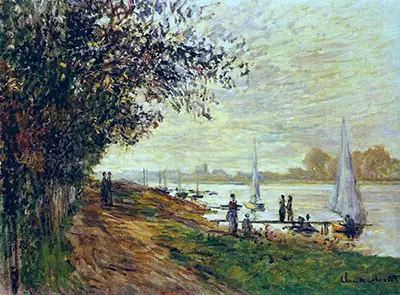For most people, if they think of Impressionist painting, it is the work of Monet that springs immediately to mind. It was he who demonstrated, in masterpiece after masterpiece, just what Impressionism is capable of achieving.
He demonstrated how a single painting can depict a scene in figurative terms while, at the same time, capturing the subjective impression of the observer. He demonstrated how representation and abstraction can blur together, creating something truly outstanding.
In his art, Monet touched upon something deep and profound within the human soul. This is why his paintings will be admired and appreciated by art lovers for generations to come.
The Riverbank at Petit Gennevilliers Sunset is typical of Monet's masterpieces. The scene depicted is one of everyday tranquillity, as bystanders on a wooded riverbank observe small boats on the water.
At first glance it will seem merely an attractive scene as depicted by a talented painter, but once it has captured the eye of the observer, it reveals hidden depths. A close inspection will reveal how the more literalistic elements (the figures and the boats) are standing against a background that blurs into abstraction.
The sky, the water and the path along the riverbank are all created using essentially the same strokes; it is only the choice of colour that differentiates them.
And yet, through these loose strokes of his brush, Monet has created an easily recognisable setting: the observer can almost hear the sound of the flowing river, can almost smell the springtime flowers, can almost see the tree blowing in the wind.
Further notable artworks from around this period include Woman with a Cat by Renoir, A Bar at the Folies Bergeres by Manet, Green Dancer by Degas and Wheatfield with Crows by Van Gogh.
As with all the best Impressionist paintings, The Riverbank at Petit Gennevilliers Sunset gives what is essentially an overview of a complete scene, made up from individual impressions, all slotting together to create a whole. Monet depicts not solid objects but light and shade - or, perhaps, the impressions of light and shade.
Through his astute choices of colour, these impressions blur together to form a more complete picture. In this way, Money has recreated how people observe scenes: real-life impressions and memories of impressions are formed not from complete scenes but rather from little details that connect one by one. Herein lies the sol of the Impressionist movement.
Claude Monet and his contemporaries sought not to capture scenes as they are, but as how people see and interpret them.
As a fine specimen of the Impressionist movement at its best, Claude Monet's The Riverbank at Petit Gennevilliers Sunset makes a handsome print for the home of any art lover. The infrared on the wall, it will improve the spirit of any room, and will make the ideal talking point amongst any household guests.


